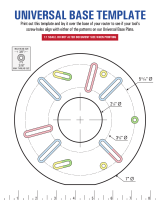
11.2. Non-Standard Printouts ........................................................................................................................... 36
11.3. Dosing Report Printouts .......................................................................................................................... 37
11.4. Formulation Report Printouts .................................................................................................................. 37
11.5. Vehicle Weighing Report Printouts ......................................................................................................... 38
11.6. Adjustment Report Printouts ................................................................................................................... 40
12. INPUTS / OUTPUTS ...................................................................................................................................... 40
12.1. Input Setup .............................................................................................................................................. 40
12.2. Output Setup ........................................................................................................................................... 41
13. DISPLAY ........................................................................................................................................................ 42
13.1. Workspace............................................................................................................................................... 42
13.1.1. Label ............................................................................................................................................. 42
13.1.2. Text Box ....................................................................................................................................... 44
13.1.3. Bar Graph ..................................................................................................................................... 44
13.2. Keys ......................................................................................................................................................... 46
13.3. Default Screen Settings........................................................................................................................... 48
14. PERMISSIONS ............................................................................................................................................... 48
14.1. Anonymous Operator .............................................................................................................................. 48
14.2. Date and Time ......................................................................................................................................... 49
14.3. Printouts .................................................................................................................................................. 49
14.4. Database Editing ..................................................................................................................................... 49
14.5. Select Database Record ......................................................................................................................... 50
15. UNITS ............................................................................................................................................................. 50
15.1. Units Availability ...................................................................................................................................... 50
15.2. Start Unit.................................................................................................................................................. 50
15.3. Gravitational Acceleration ....................................................................................................................... 51
15.4. Custom Units ........................................................................................................................................... 51
16. MISCELLANEOUS PARAMETERS .............................................................................................................. 51
16.1. Interface Language ................................................................................................................................. 52
16.2. 'Beep' Sound ........................................................................................................................................... 52
16.3. Display Brightness ................................................................................................................................... 52
16.4. Proximity Sensors Sensitivity .................................................................................................................. 52
16.5. Date and time .......................................................................................................................................... 53
16.6. Backlight Standby Time........................................................................................................................... 53
16.7. Automatic Shutdown ............................................................................................................................... 53
16.8. Logging In Required ................................................................................................................................ 54
16.9. Passwords Type ...................................................................................................................................... 54
16.10. Codes Type ........................................................................................................................................... 54
16.11. Default Operator Settings ..................................................................................................................... 54
17. ADJUSTMENT ............................................................................................................................................... 55
17.1. External Adjustment ................................................................................................................................ 55
17.2. User Adjustment ...................................................................................................................................... 55
17.3. Start Mass Determination ........................................................................................................................ 55
17.4. Adjustment Report................................................................................................................................... 56
18. SCALE DATA ................................................................................................................................................. 56
19. WORKING MODES – General Information ................................................................................................. 56
19.1. How to Run the Working Mode ............................................................................................................... 56
19.2. Working Mode Accessibility .................................................................................................................... 57
20. WORKING MODES - Local Settings ............................................................................................................ 57
20.1. Readout ................................................................................................................................................... 58
20.2. Proximity Sensors ................................................................................................................................... 58
20.3. Save Mode .............................................................................................................................................. 58
20.4. Cyclic Record Mode ................................................................................................................................ 59
20.5. Auto Threshold ........................................................................................................................................ 59
20.6. Result Control .......................................................................................................................................... 60
20.7. Dispensing ............................................................................................................................................... 60
20.8. Tare Mode ............................................................................................................................................... 61
20.9. Labelling Mode ........................................................................................................................................ 61
20.9.1. Automatic C Label Triggering ...................................................................................................... 61
20.10. Statistics ................................................................................................................................................ 62
21. WORKING MODE – WEIGHING ................................................................................................................... 63
21.1. Home Screen........................................................................................................................................... 63
21.2. Local Settings .......................................................................................................................................... 63
22. WORKING MODE – PARTS COUNTING ..................................................................................................... 64
22.1. Home Screen........................................................................................................................................... 64
22.2. Local Settings .......................................................................................................................................... 64






















